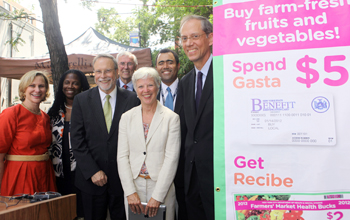
Share On Social!
Many doctors in New York City will now be prescribing more than just medicine.
The Fruit and Vegetable Prescription Program is being brought to New York City for the first time in a pilot program at Lincoln Medical Center in the Bronx and Harlem Hospital Center in Manhattan.
The Fruit and Vegetable Prescription Program (FVRx) is a nationally-recognized program by Wholesome Wave under which a doctor and nutritionist assess the health and nutritional habits of patients and families at risk for obesity and give patients “prescriptions” to consume more fruits and vegetables. FVRx patients at the two hospitals will then receive Health Bucks, which are coupons from the Human Resources Administration and the Health Department that can be redeemed for fruit and vegetables at all of New York City’s 142 farmers markets.
This year, Health Bucks will make more than $560,000 worth of fruits and vegetables available to low-income New Yorkers, an increase of 32 percent over the previous season.
According to the press release, New York City, which has the largest municipal farmers market SNAP incentive program in the nation, is also making fruit and vegetables more affordable than ever by expanding the Health Bucks program – which provides $2 coupons for fresh produce at farmers markets. This year, Health Bucks will make more than $560,000 worth of fruits and vegetables available to low-income New Yorkers, an increase of 32 percent over the previous season.
“Our vision for the Fruit and Vegetable Prescription Program is that it will lead us all to view farmers markets as pharmacies providing access to healthy affordable locally-grown fruits and vegetables,” said Wholesome Wave Executive Vice President Gus Schumacher.
If you live in NYC, click here to find a farmers’ market near you!
Read more about the program and here an interview with the president of Wholesome Wave here!
By The Numbers
1
Supermarket
for every Latino neighborhood, compared to 3 for every non-Latino neighborhood



